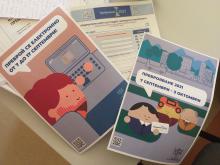The electronic questionnaire comprises questions in four main sections – address, dwelling, household and population. The fifth one – temporarily present persons – is filled in only in case that during the census there are people who do not usually live in the dwelling – for example, guests for a few days. You could see a paper questionnaire sample on the link. The electronic questionnaire comprises the same information with only the information about the building excluded.
One questionnaire counts one dwelling and all people who usually live there. Most of the questions are close-ended – only the correct answer is marked down.
Data are collected about the ownership of dwelling – state, municipal or private, its area, number of rooms, availability of insulation and energy-saving windows, availability of an accessible environment for persons with reduced mobility, incl. for people with disabilities, etc. The dwelling section is completed regardless of your type of tenure – owner, tenant or user.
In the next section you should fill in information about the number of persons and households which inhabit the dwelling. A household can be one person who lives alone or more persons who live together and have common budget. In one dwelling there can be more than one household – for example two students who live in the same flat but do not have common expenses.
You should also complete data for each person in the dwelling. It is recommended that you start with the head of the household or other person of 18 years old or over. Names of people and their personal identification numbers are filled in, and the relationships between family and household members should be marked down – for example if in a dwelling lives a family with two children and a grandmother and the household head is the man, the relationship between the woman and him is spouse, those of the children – son/daughter and that of grandmother – parent (in case of his mother) or other non-relative (in case of his mother-in-law).
The next questions are for ethnic group, mother tongue and religion. By answering these questions, a person self-identifies. There is also an option to mark down “I cannot determine” or “I do not want to answer”. This section also contains the information whether you are you a student or if you work, the place of your work and what your job is, how you travel to your place of school/work.
All data that you complete in the questionnaire are protected, and by law they can be used only for statistical purposes, they are not provided to other authorities and cannot be used as evidence in the court.
You can see how to fill in the electronic questionnaire by yourselves here .



